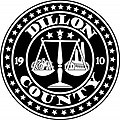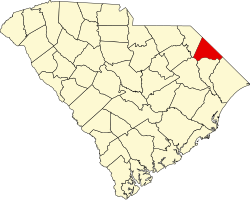2010 census
At the 2010 census, there were 32,062 people, 11,923 households, and 8,342 families living in the county. [14] [12] The population density was 79.2 inhabitants per square mile (30.6/km2). There were 13,742 housing units at an average density of 33.9 per square mile (13.1/km2). [15] The racial makeup of the county was 48.0% white, 46.1% black or African American, 2.5% American Indian, 0.2% Asian, 1.5% from other races, and 1.6% from two or more races. Those of Hispanic or Latino origin made up 2.6% of the population. [14] In terms of ancestry, 13.5% were American, 6.5% were English, and 5.4% were Irish. [16]
Of the 11,923 households, 36.5% had children under the age of 18 living with them, 40.2% were married couples living together, 23.9% had a female householder with no husband present, 30.0% were non-families, and 26.5% of all households were made up of individuals. The average household size was 2.65 and the average family size was 3.20. The median age was 36.7 years. [14]
The median income for a household in the county was $26,818 and the median income for a family was $34,693. Males had a median income of $31,973 versus $22,100 for females. The per capita income for the county was $14,684. About 26.2% of families and 30.5% of the population were below the poverty line, including 43.8% of those under age 18 and 23.7% of those age 65 or over. [17]
2000 census
At the 2000 census, [18] there were 30,722 people, 11,199 households, and 8,063 families living in the county. The population density was 76 people per square mile (29 people/km2). There were 12,679 housing units at an average density of 31 per square mile (12/km2). The racial makeup of the county was 47% White, 49% Black or African American, 2.21% Native American, 0.34% Asian, 0.03% Pacific Islander, 0.99% from other races, and 0.70% from two or more races. 1.75% of the population were Hispanic or Latino of any race.
There were 11,199 households, out of which 34.60% had children under the age of 18 living with them, 44.80% were married couples living together, 22.30% had a female householder with no husband present, and 28.00% were non-families. 25.10% of all households were made up of individuals, and 9.90% had someone living alone who was 65 years of age or older. The average household size was 2.71 and the average family size was 3.24.
In the county, the population was spread out, with 29.10% under the age of 18, 9.50% from 18 to 24, 27.50% from 25 to 44, 22.40% from 45 to 64, and 11.50% who were 65 years of age or older. The median age was 34 years. For every 100 females there were 87.40 males. For every 100 females age 18 and over, there were 81.60 males.
The median income for a household in the county was $26,630, and the median income for a family was $32,690. Males had a median income of $26,908 versus $18,007 for females. The per capita income for the county was $13,272. About 19.40% of families and 24.20% of the population were below the poverty line, including 33.30% of those under age 18 and 26.60% of those age 65 or over.






